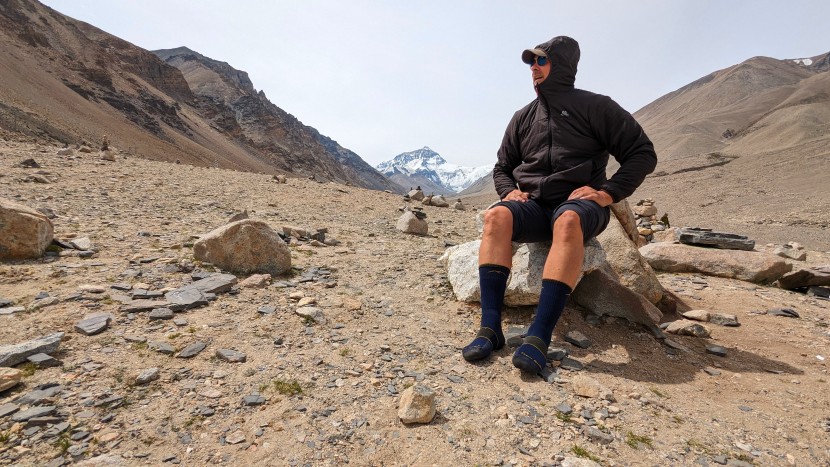We put each pair of our tested socks through the wringer. From the high mountain peaks of Colorado, Alaska, Peru, Italy, and Tibet to the deserts of southern Utah to the coastal redwood trails of California, we hiked, backpacked, boarded, and ran backcountry trails to test the limits of each contender. We tested in all types of weather through a wide range of temperatures, from the hottest days of summer to the coldest of winter nights. In addition to field tests, we performed in-lab tests to determine performance differences. Each sock was rated based on its comfort, warmth, breathability, durability, and drying speed. Below, we outline the specific tests for each.
Comfort
When considering comfort, we compared the level of cushion, the amount of compression paneling, relative fit, and overall coziness. The testing was simple. We tried each on, slept with them, hiked in them, and compared their properties. We even wore different socks on each foot to compare the relative cushioning and hiking capabilities side by side.
Wicking and Breathability
To test breathability and wicking capabilities, we wore each pair while performing high- and low-intensity activities. Trail running and hiking in each sock in warm weather was the best tell-tale sign of wicking and breathability. Wearing different socks allowed us to see which foot felt hotter or less comfortable. We adventured through the high Peruvian Andes, the jagged Utah and Colorado Rocky Mountains, and across the Italian Alps. We even plowed through snow and trudged through deserts in order to test our lineup in a wider variety of temps and climates.
Warmth
This was measured using two sub-metrics: wet warmth and dry warmth. For wet warmth, we soaked each sock in water, put it on, and walked around in the cold to evaluate if the model held its warmth in use. For dry warmth, we stood around on cold winterish nights or slept in the socks to note whether our toes stayed warm. We also wore different socks on each foot to get a specific comparison.
Durability
To test durability, we looked at relative wear and tear over roughly 60 miles of testing. This included compression of cushioning, holes, pilling, misshapen fabrics, etc. We even hiked around in bare sock feet on the pavement (yikes!) to determine which were most susceptible to sole wear. We noted the quality of the fabric before and after this testing period. Products that demonstrated little to no wear scored high, while those that showed obvious wear scored low.
Drying Speed
Our drying tests were two-fold. First, we took each sock into the field and got it soaked. We then put them on rocks to dry out. This provided us with real-field-based data that yielded decent results but not objective ones. So, we confirmed our outdoor tests with a much more objective in-lab test. Each sock was soaked, wrung out, hung on a line, and weighed every ten minutes to determine the relative amount of moisture in the sock. This allowed us to determine which socks dried fastest, held the most water, and dried the slowest.
- Step 1: weigh (in grams) each sock when dry - this is our control weight
- Step 2: dunk each sock underwater and squish around for one minute
- Step 3: wring each sock out as best we can until no more drops of water come from the fabric
- Step 4: weigh each sock when wet (this is time = zero minutes)
- Step 5: hang on the line
- Step 6: at 10-minute intervals, weigh each sock and record the weight in grams - continue until the sock is back to its dry weight and record dry time for each sock
- Step 7: evaluate and analyze data
Conclusion
Our at-home tests were simple but very effective in helping us determine which sock would be our favorite for a variety of conditions and situations. We air-dried our socks, walked them repeatedly across our driveway, used a Bluetooth thermometer to test for warmth, and even donned them at work. However, the thing we did the most was hike in them — all over, every day. And, after hundreds of miles, we're positive about the ones we liked and the ones we didn't.



